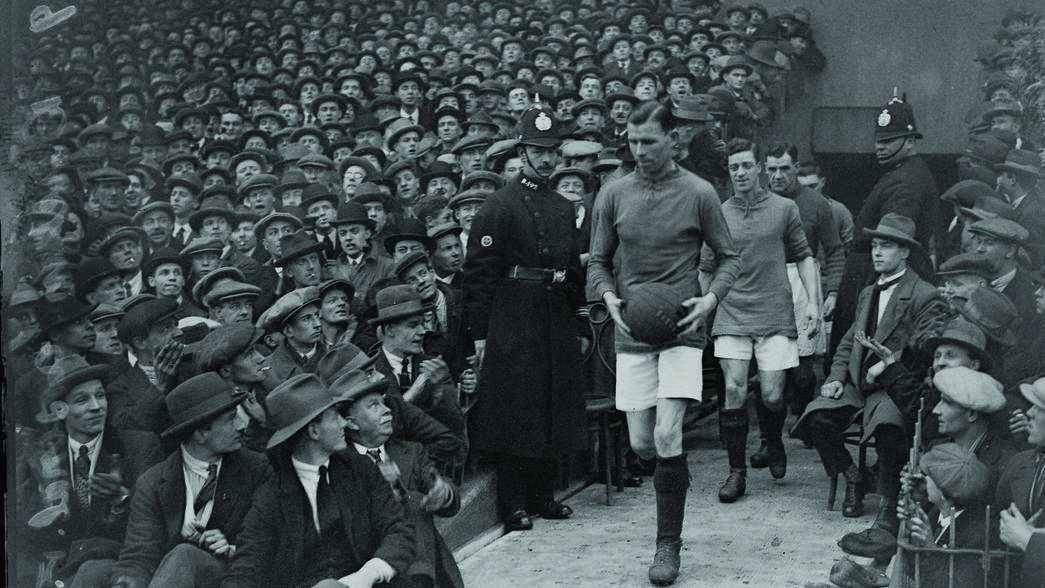“Gentlemen whose sole ability to build up a good side depends on the payment of heavy and exorbitant transfer fees need not apply”
Athletic News, May 11, 1925
After Arsenal dispensed with the services of manager Leslie Knighton, an advertisement was placed in Athletic News at the behest of chairman Sir Henry Norris, inviting prospective candidates to apply for the position of team manager.
The posting referred specifically to candidates’ ability and personal character, with the club looking for the “highest qualifications” in both areas. But it was the reference to Arsenal’s reluctance to pay “heavy and exorbitant transfer fees” that set the man who would fill the post – one Herbert Chapman – a real challenge, particularly after the former Huddersfield Town supremo decided to put the feelers out for Sunderland’s legendary forward Charlie Buchan, who had plundered 224 goals in 413 games during a brilliant 15-year spell on Wearside.
Legendary Gunners winger Joe Hulme explained, “Herbert Chapman knew that football was all about entertainment, and that supporters like to see big names.”
When Chapman strode purposefully into Buchan’s gentleman’s outfitters shop in Sunderland and informed the 33-year-old Plumstead-born Buchan that he would not leave until he’d secured his signature, he put into motion arguably the most talked-about transfer of the decade. Sir Henry Norris was unwilling to pay the required £4,000 fee in one lump sum and instead set up a deal in which Sunderland received £2,000 up front, and £100 for each goal Buchan scored in an Arsenal shirt.
The deal would eventually cost the Gunners £4,100, once Buchan had finished scoring goals in N5 with his customary aplomb.
Chapman remains perhaps Arsenal’s most influential manager, but the many biographies that have been penned about him don’t give Buchan adequate credit for the foundations of success that were laid in the latter part of the 1920s, aside from the deployment of the WM formation, in which Buchan played a key role.

Footballers weren’t the celebrities then that they are now, but Buchan wasn’t shy of the limelight. Here he leads a team line-up for their photocall before the 1927 FA Cup final
In Buchan, Chapman had gained a highly experienced, ground-breaking player. Proving that with a degree of imagination and hard work it was possible to circumnavigate the restrictive maximum wage system, he opened up his sports outfitters in Sunderland after the First World War, lamenting that it brought him greater financial reward than his footballer’s wage. It brought him castigation from the FA, who wrote to him warning, “Your business activities will not, we trust, affect your performances on the pitch.”
Buchan also penned articles for various newspapers, further broadening his horizons. His aura was quite unlike anyone else’s in the game, and he and Chapman saw eye to eye on the potential for building a dynasty in the capital city. “What a chance there is in London. I would like to build a Newcastle United there,” a thrilled Chapman told writer Ivan Sharpe in 1914 after an early visit to Highbury.
And Hulme recalled Buchan saying that although he’d loved his long spell in Sunderland, he was “looking forward to making a name for himself in London”. Buchan’s baptism as an Arsenal player on the opening day of the 1925/26 campaign couldn’t have been more high profile. Arsenal would face Tottenham.
They wouldn’t have known it at the time, but the 53,183 Arsenal fans who streamed into Highbury to watch the north London derby were about to witness the early stages of a football revolution, albeit in far less grandiose surroundings than those that would exist when Chapman died in 1933.
The Gunners lost 1-0 under the scorching sun to a goal by Tottenham’s Jimmy Dimmock, after Arsenal defenders Andy Kennedy and Billy Milne indulged in a spot of “after you, please”, according to the Daily Gazette. Arsenal regulars slipped away disappointed, but were aware of Chapman’s advice to “not expect too much in too little time.”

Despite captaining the side and going close to scoring, Buchan couldn’t quite help Arsenal to their first major honour, losing the 1927 FA Cup final 1-0 to Cardiff City
Despite drawing a blank in his first four matches, the hype surrounding Buchan was sensational, and the press descended on Highbury to snap him in action for his new club. The Times was mightily impressed with the club’s new signing, commenting, “Some of his touches reveal the master mind of a great thinker.”
Tellingly, The Sporting Life and Sportsman reported, “The turnstiles were still clicking merrily, and later in the afternoon it was officially announced that the attendance was 53,000, a great send-off from a financial point of view.” Gunners fan Leslie Anderson recalled: ‘Highbury was a sprawling bowl back then. By the time Herbert Chapman arrived it held 50,000 but it was always half empty, because the team was a bit of a letdown, really. Then it all changed in 1925. I can remember the great Charlie Buchan making his debut for Arsenal like it was yesterday. He had genuine star quality…”
Almost a century on, the sense of wonder is visible on fans’ faces on the photographs as the team’s new talisman leads out his new team-mates against Tottenham. “Whenever we stepped out into the streets near Highbury, supporters wanted to rub shoulders with Charlie,” recalled Hulme. “Whether it was to get his autograph or simply take a look at him, he was the one that everyone wanted to see. Because of his height, he stuck out a mile, and everyone wanted to see him.”
It didn’t stop the supporters criticising Buchan for his initial goal drought, though – and he had to endure listening to their barbed criticisms of his lack of goals on the Tube near the ground, but after he scored at home to Liverpool in September – his fifth game – he didn’t look back. Buchan scored in wins against Leeds United and West Ham in September, and following a 7-0 hammering at Newcastle United in early October he played a key role in formulating the tactical blueprint that was the basis of Arsenal’s success in the 1930s.
But first and foremost, Charlie Buchan was Arsenal’s first superstar player. Quite how Chapman convinced Norris to circumnavigate his own transfer ruling remains unclear, but it was the most important task he completed during his early days at Highbury.
By Jon Spurling
This article first appeared in the matchday programme, which can be purchased here: https://programme.arsenal.com/
Copyright 2025 The Arsenal Football Club Limited. Permission to use quotations from this article is granted subject to appropriate credit being given to www.arsenal.com as the source.




